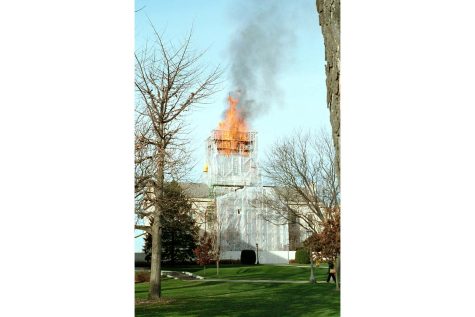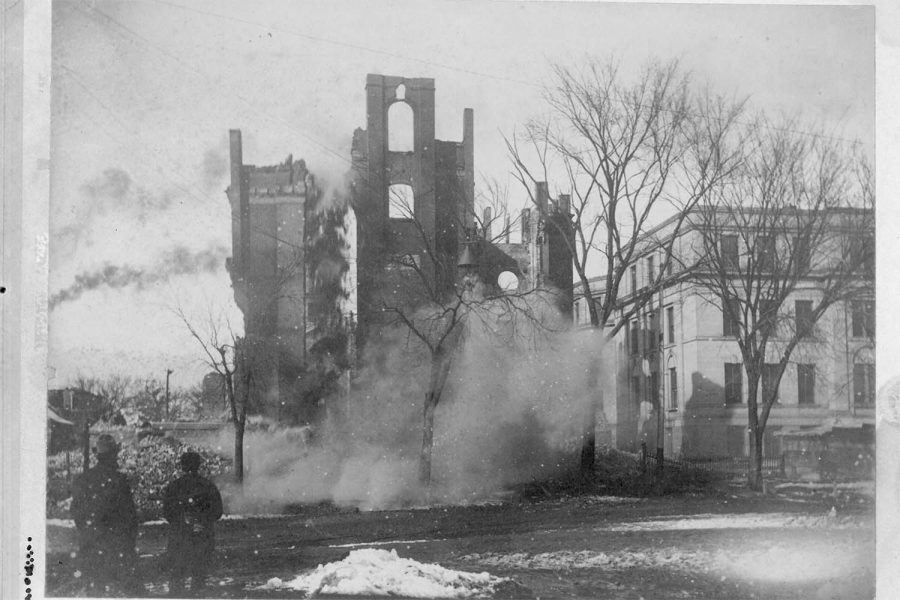After 175 years, a reflection on natural disasters at the UI
Over the first 175 years of the University of Iowa’s history, the campus has faced a wide range of natural disasters including fires and widespread flooding.
Ruins of the Medical Lab.
February 22, 2022
Across the University of Iowa’s 175-year history, the campus community has experienced a wide-range of disasters including tornadoes, flooding, and fires.
The most impactful events include the 2008 flood and fires at South Hall, the old library building, and the Old Capitol Building.
The 2008 flood inflicted $750 million in damage to 22 campus buildings including the old Hancher Auditorium building, which was destroyed in 2013, and the Art Building, which has since been decommissioned.
Mary Bennett, historian and archivist at the State Historical Society of Iowa, has lived through the three most recent disasters in her 50 years in Iowa City. Bennett graduated from the university in the 1970s.
Bennett said she remembers the wide-ranging destruction caused by the 2008 flood and that generally, it was difficult to get around town with Dubuque Street and the Park Road Bridge submerged.
“I think that the whole community was so impacted,” Bennett said. “There wasn’t anybody who wasn’t touched by the floods, whether you were a university student or just someone who lived in the town.”
In those moments of peril, Bennett said she was touched by moments of unity in the community, including sandbagging efforts around the Iowa Memorial Union and transporting books from the basement to higher levels of the Main Library.
“Hundreds of students and volunteers came to empty out the books and materials that were vulnerable right before the water hit,” Bennett said. “I remember seeing them passing books [from] one person to another. It was wonderful seeing the university community step up like that to rescue those treasures.”
Rod Lehnertz, who was the director of planning, design, and construction in 2008 and is the current UI senior vice president of finance and operations and architect, called the Iowa flood one of the biggest moments in campus history.
It was a moment, he said, where everyone “lost their title,” with the Iowa City community’s student-athletes, inmates, and multitudes of other groups pitched in to help with flood preparation. Lehnertz said once those barriers gave way, they were there to help with recovery.
“Everyone dropped what they were doing, dropped their egos, and tried to help in any way they could,” Lehnertz said. “It was remarkable, some of the most challenging days of my career and yet, also, without a doubt, some of the most inspiring.”
Larry Weber, Iowa Flood Center co-founder, was the director of the hydraulics program at the time. He said the memory from the flood that will always stick with him comes from taking the first shift manning the water pumps at the hydraulics building on the night before the river crested.
“It was dark, it was empty, it was void of people,” Weber said of his experience walking back and forth on the blacked-out Burlington Street Bridge that night. “It was quiet, sort of peaceful. The calm just before the storm or just before the crest.”
Weber said there were positives coming out of the flood. As people looked for solutions to prevent flooding like this from ever happening again, the Iowa Legislature began the process of creating the Iowa Flood Center, Weber’s academic research program to study flooding in Iowa.
Fire at the Old Capitol
Weber was also on campus when the Old Capitol Building caught fire on Nov. 20, 2001, during a regilding project on the dome.
While using blowtorches to remove the current coat of paint, contractors ignited the dome and it collapsed, causing widespread water damage and fire damage.
Weber remembers being in the engineering department chair’s office at the time, on the fourth floor of Seamans Center with windows looking out over the Pentacrest. He was in shock when he saw the roof of the building catch fire.

“Flames had just popped through the rooftop,” Weber said. “Within moments, of course, we heard sirens and the fire departments were all showing up to put the fire out.”
Bennett said the contractors were negligent in the situation, especially to recognize the potential flammability of the historic dome.
“It’s something I’m personally very chagrined about because they didn’t do it right,” Bennett said. “They knew they were dealing with a treasure that was on the national register. It’s a national landmark.”
Bennett said it was “horrifying” to see the whole dome collapse when she entered the building on the night of the fire. That night, her goal was to ensure any artifacts within the building remained protected against water damage.
Her efforts included closing and covering books, moving paintings off the walls, and moving an antique wooden bench away from the water-damaged interior walls. Repairs on the building took more than four years before reopening to the public.
Twenty-five thousand books destroyed in 1897 campus fire
In 1897, North Hall, home of the university library at the time, caught fire because of an early morning lightning strike. A fire broke out and though firemen were quickly on the scene, nothing could be done to save the library.
Bennett said an assistant librarian and a few firemen entered the second floor, the location of the library, in an attempt to save some of the more than 33,000 books contained within the library.
As the librarian and firefighters fled with armfuls of books, Bennett said, the roof collapsed, trapping a fireman under the debris. He was killed in the fire.
In total, 25,000 books were destroyed in the fire, Bennett said. The library was one of the largest west of the Mississippi at the time.
North Hall was rebuilt following the fire and stood between MacBride Hall and Jessup Hall on the Pentacrest until 1949.
Four years later, in March of 1901, one of South Hall’s ten chimneys also caught on fire as the result of a different lightning strike. The fire caused massive damage that destroyed one of the few buildings on campus at the time, Bennett said.
South Hall and the adjacent medical building were destroyed. The medical library, once home to 1,200 books, was reduced to just 17 by the blaze.
These disasters over the university’s first 175 years show the unity and resilience of the University of Iowa’s campus community, Bennett said.
“People came together to rescue the treasures they could and then rebuilt the campus,” Bennett said. “One of the state’s most valuable assets [is] a premiere academic institution that rivals the nation’s best.”















